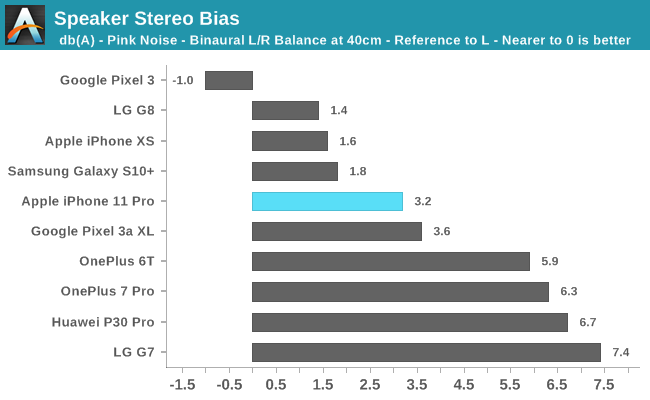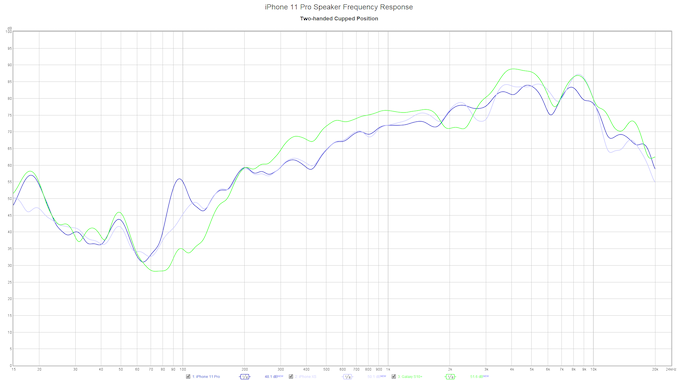The Apple iPhone 11, 11 Pro & 11 Pro Max Review: Performance, Battery, & Camera Elevated
by Andrei Frumusanu on October 16, 2019 8:30 AM ESTVideo Recording
Video recording on the iPhone is known to be extraordinarily good in terms of quality. The iPhone 11 series is said to improve in this regard thanks to an improved HDR with more dynamic range (though Apple still stores video in SDR format). Naturally of course what’s also exciting is that we’re now able to capture video with a wide-angle lens, and seeing a lot more content of a given scene.
Apple has improved the EIS this generation, and it now results in a much smoother video capture experience than the past iterations. When you have with a lot of detail in a scene though, you can sometimes see the jitter caused by the OIS and EIS interacting with each other.
In the wide-angle recording, the EIS was a bit haphazard. In the first part of the video walking down the path it doesn’t look to be stabilizing much at all, when I turn left to the second path suddenly the EIS kicked in and things were a lot less shaky, and it then again loses the stabilization for few steps until it finally resumes again. This happened all three recordings with the wide-angle camera, and I don’t know it was me holding the phone any different between those two paths.
The quality and detail of the videos are all great. The one thing noticed though is that there’s the occasional exposure flicker in some areas. In effect Apple here is doing two exposures per frame and combining them together like Smart HDR – we can notice that in parts of the scene, and most visible the sky is flickering or pulsing in brightness.
The handling between the three camera sensors is very good, it’s particularly fast and seamless to switch between the main and wide-angle modules, while there’s a small delay to switch to the telephoto module. Switching between the three modules is only possible in 30fps recording modes; it’s still possible to record 60fps in any of the three modules but you have to start out the video with the camera that you want to use, and you’ll be limited to digital zooming only while recording.
Speaker Evaluation
In terms of audio for the iPhone 11 series, Apple’s big addition is the inclusion of Dolby Atmos. Naturally you have to watch multi-channel audio content to be able to take advantage of the feature. For regular stereo audio playback, we investigate if Apple has done any changes to the speaker setup and if it differs to that of the XS.

In terms of audio volume, the iPhone 11 Pro is ever so slightly quieter when being held in portrait mode. The bigger difference that’s definitely more audible is when holding the phone in landscape mode with both hands and the palms cupped – the usual way one would hold a phone in landscape. Here it’s 3dB quieter than the iPhone XS, which is a noticeable amount.

Investigating the phone’s stereo bias thanks to a binaural microphone setup, we see that that things have notably regressed for the iPhone 11 Pro when compared to the XS. It’s relatively normal for the main speaker (Right side) to appear louder, however it’s extremely weird that it’s now 1.6dB more biased than on the iPhone XS. Indeed when comparing the 11 Pro and XS side-by-side, and muting the main speaker by holding a finger on it, volume being equal and otherwise calibrated between the two phones, it’s immediately audible that the 11 Pro earpiece speaker is much quieter compared to what we experience on the XS.
This has a rather large knock-on effect on the spatial sound reproduction of the 11 Pro as it just isn’t able to fill up the surrounding area quite as well as on the XS.
Looking at the frequency response between the 11 Pro and the XS, we see that things are extremely similar up to the high mid-ranges, with a more noticeable peak at 95Hz for the 11 Pro. Towards the treble we see some more deviations, it’s here that the 11 Pro is a bit quieter and I think that’s due to the weaker earpiece speaker.
Overall, the sound signature of the iPhone 11 Pro hasn’t changed all too much, and it is actually more of a downgrade in audio playback due to the weaker earpiece speaker calibration. The Galaxy S10’s notably stronger lower mid-range and mid-range still make for a much superior audio playback and is in my experience the device to beat in terms of speaker quality.











242 Comments
View All Comments
HammerStrike - Wednesday, October 16, 2019 - link
FYI, while al other new models are rated IP68, the pro’s are listed as having a maximum submerged depth of 4 meters for 30 minutes, vs 2 for the non-pro model. Your spec comparison on the first page lists them all at 2 meters.colonelclaw - Wednesday, October 16, 2019 - link
I think my perfect phone right now would be all of the 11 Pro's hardware shoved into the body the size of the iPhone 5, but obviously with the full-front screen. Unfortunately there doesn't appear to be much will amongst any of the premium phone manufacturers in wanting stuff to be smaller these days :(iPhone 11 Pro Nano anyone?
p1esk - Wednesday, October 16, 2019 - link
Yes, I’d love a smaller iPhone.nirolf - Thursday, October 17, 2019 - link
Smaller and lighter! I'm holding on to my 7 until they release something similar in size.Eliadbu - Wednesday, October 16, 2019 - link
no iphone 11 pro but *rumors* say there is new Iphone SE2 for 399$ with a13 and 3GB of rambut I doubt it will be full front screen or AMOLED screen. but imo it will sell like hot buns from the oven. there is huge market for budget phone and a new iphone SE with same SOC as flagship, plenty of ram and IOS for 399$ is really compelling I know many people just lurk for used\old gen Iphones just so they can get Iphone for low price, this phone will draw the masses.
MamiyaOtaru - Friday, October 18, 2019 - link
unfortunately the rumors seem to paint Apple as being more interested in the price aspect than the size aspect. Like it will be more modern innards in an iphone 8 body. Which misses a great deal about what I liked in the original SE.Eliadbu - Saturday, October 19, 2019 - link
I see your point, but you need to understand the current market. Iphone sales and other premium flagship are declining while budget phones are on the rise especially in certain markets where most people can't afford expensive phone so they look for the best phone they can get at the budget lineup. Now there are cheaper options than 399$ but arguably no better options. Apple knows it loses huge market share by not creating option for that price point. Also if they put a13 in that phone it will be overkill. They should either use older chips that cost less now like the a12 or a11 which both are more than enough for budget phones, or they can use smaller more power efficient a13 that would cost less and put the money on newer display design or more cameras which will be better selling point than using a13, imo.Srkifs2021 - Tuesday, November 3, 2020 - link
Guess you got it now with the 12 and mini!Oyster - Wednesday, October 16, 2019 - link
I believe it's time for AT to really upgrade its website to be able to make use of the full width of modern displays. It's excruciating to go through these reviews and click through each camera sample without being able to compare things side-by-side. Even the performance graphs are so cramped. I hope an upgrade is on the way...Raqia - Wednesday, October 16, 2019 - link
"Nevertheless, I do question why Apple decided to be so aggressive in terms of power this generation."I imagine it has something to do with the much bigger battery they put into the phone; current draw wearing down the battery isn't as much of a concern when it is larger. The little cores are far more impressive this year with roughly A73-75 levels of performance at much better efficiency. They seemed to have listened to users by making the phone a bit chunkier in exchange for a bigger battery.
The inefficient modem is still a sore spot this year which should hopefully be addressed next year with the inclusion of Qualcomm parts and IP. More importantly, the impact of a closed ecosystem with management who care more about profit than users is being felt by real customers in places like Hong Kong or vendors like EPIC who have avenues other than the official OS vendor sponsored app store on Android. Regulators should force Apple to offer an open store API for third parties to set up store fronts so that customers could have more choice based on pricing, quality, and reputation.